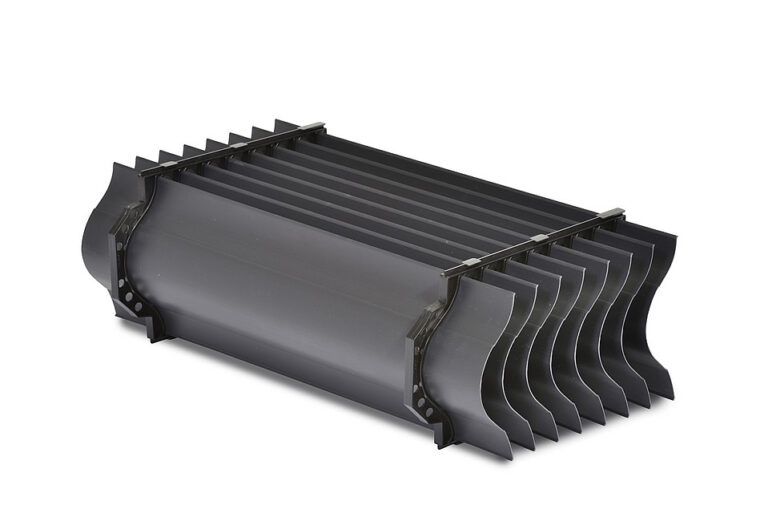Introduction
Drift eliminators are essential components in cooling towers, designed to minimize the loss of water droplets (known as “drift”) from the cooling tower into the environment. In India, where industries face water scarcity and strict environmental regulations, selecting the right type of drift eliminator is crucial to conserve water, reduce environmental impact, and comply with local regulations.
Blade Drift Eliminators
- Design: Blade drift eliminators consist of multiple blades arranged in a specific pattern to capture and remove water droplets from the air before they exit the cooling tower. The design forces the air to change direction multiple times, causing water droplets to collide with the blades and fall back into the tower.
- Material: Typically made from PVC, polypropylene, or fiberglass, blade drift eliminators are resistant to corrosion and UV radiation, making them suitable for various industrial applications in India.
Cellular Drift Eliminators
- Design: Cellular drift eliminators feature a honeycomb-like structure that maximizes the surface area for capturing water droplets. The air passes through the small cells, causing water droplets to condense and fall back into the cooling system.
- Material: Typically constructed from PVC or polypropylene, cellular drift eliminators offer high resistance to chemical corrosion and UV degradation, which is essential in industrial settings exposed to harsh environmental conditions.
Vane Drift Eliminators
- Design: Vane drift eliminators consist of a series of vertical vanes that create sharp changes in airflow direction. As air passes through the vanes, the water droplets are separated from the airflow and redirected back into the cooling tower basin.
- Material: These eliminators are often made from durable materials like PVC or stainless steel, providing long-lasting performance in industrial applications where chemical exposure and temperature variations are common.
Mist Eliminators
- Design: Mist eliminators are designed to capture fine water mist or aerosol-sized droplets from the cooling tower’s exhaust air. They typically consist of fine mesh or fiber-based materials that trap and coalesce water droplets into larger droplets, which then fall back into the system.
- Material: Commonly made from polypropylene or stainless steel mesh, mist eliminators can withstand high temperatures and corrosive environments, making them suitable for use in chemical and pharmaceutical industries
Modular Drift Eliminators
- Design: Modular drift eliminators are constructed from multiple interlocking modules that can be easily assembled to fit cooling towers of any size. These eliminators combine the features of blade and cellular designs to provide high-efficiency drift control.
- Material: Made from PVC or polypropylene, these eliminators offer a lightweight, corrosion-resistant solution for cooling tower drift management.
High-Temperature Drift Eliminators
- Design: These drift eliminators are specifically designed to handle the high temperatures found in certain industrial cooling applications. They use reinforced materials that can withstand extreme heat while maintaining their structural integrity.
- Material: Typically made from high-grade stainless steel or specially treated fiberglass, these eliminators are built to resist thermal expansion and warping in high-temperature environments.
Resistance to Local Climatic Conditions
- Weather Resilience: Indian industrial cooling towers operate in a wide range of climatic conditions, from extreme heat in desert regions to high humidity in coastal areas. Drift eliminators should be chosen based on their ability to withstand local weather conditions without degrading or losing efficiency over time.
- UV Resistance: In regions with high levels of sunlight, selecting UV-resistant materials is crucial to prevent degradation and maintain the performance of the drift eliminators.
Compliance with Indian Regulations
- Central Pollution Control Board (CPCB) Compliance: Drift eliminators must meet the guidelines set by the CPCB for industrial emissions, especially in industries where chemical drift could affect local air and water quality. Ensuring compliance with these regulations helps avoid legal penalties and contributes to environmental sustainability.
- Water Usage Regulations: Indian industries face increasing pressure to reduce water consumption. Choosing the right drift eliminator can play a critical role in complying with water usage regulations, particularly in water-scarce regions where limits are strictly enforced.
Local Manufacturing and Sourcing
- Indian-Made Drift Eliminators: Some Indian manufacturers produce high-quality drift eliminators that are designed to meet local industry requirements. Sourcing from local suppliers can reduce costs, support the Indian economy, and provide faster access to spare parts and maintenance services.
- Availability of Spare Parts: When selecting a drift eliminator, consider the availability of spare parts and the ease of sourcing replacements within India. This is crucial for minimizing downtime and ensuring continuous operation of the cooling tower.
Cost-Benefit Analysis
The selection of drift eliminators for Indian industrial cooling towers involves considering various factors, such as water conservation, energy efficiency, material durability, and compliance with local regulations. By understanding the specific needs of your industry and environment, you can choose the right type of drift eliminator that optimizes cooling tower performance while aligning with sustainability goals and operational cost savings.

